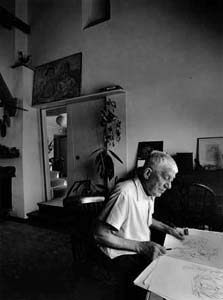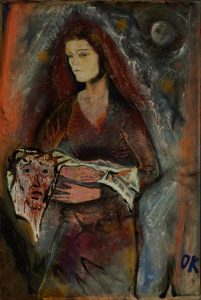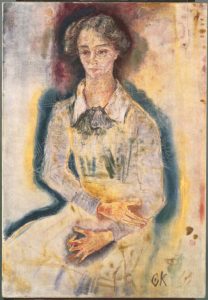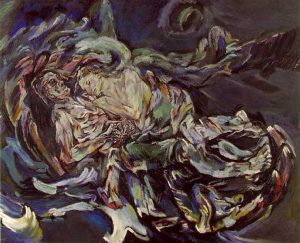Oskar Kokoschka, an Austrian painter, and writer was one of the greatest exponents of Expressionism. His dramas, poems, and prose are significant for their psychological intuition and stylistic audacity.

Image source:https://wikioo.org/paintings.php?refarticle=8XX9FA&titlepainting=Dolomite%20Landscape&artistname=Oskar%20Kokoschka
Oskar Kokoschka was an Austrian artist and poet known for his Expressionist portraits and landscapes. His works are characterized by detached brushstrokes and bright colors seem to shiver with energy. “How do I define a work of art?” he once asked. “It is a timid attempt of a man to repeat the miracle of which the simplest peasant woman is capable in every moment, that of magically producing life out of nothing.”
Early life and studies

Image source:https://commons.wikimedia.org/wiki/File:Oskar_Kokoschka_(1963)_by_Erling_Mandelmann.jpg
Oskar Kokoschka was born in 1886 in Pöchlarn, a town on the Danube, 100 kilometers west of Vienna. His father Gustav, from a German patrician family of goldsmiths, was a street vendor and, his mother Maria Romana (née Loidl) was the daughter of a forester from the state of Styria in southeastern Austria. Compared to his childhood Kokoschka claimed that he was a very happy child and that his father gave him books that formed him as a man and an artist, among theme there was a shortened version of the Odyssey and the Orbis Sensualium Pictus, a textbook for children of 1658 written by the Czech educator John Amos Comenius. From there began his appreciation for classical literature and the arts.
Vibrant landscapes
In 1908 he met the Viennese architect Adolf Loos, who was struck by one of Kokoschka’s first paintings and became interested in the young artist. During this early period, Kokoschka mainly painted landscapes, developing a technique of vibrant, fluid lines and expressive colors.

Image source: https://www.wikiart.org/en/oskar-kokoschka/dent-du-midi
At first glance, Kokoschka’s landscapes seem to follow the principles of the Impressionist school due to their bright colors, ephemeral delineation of forms, and concern for light. His vision, however, was different from that of the Impressionists, who only wanted to represent what strikes the eye. Kokoschka through his colors tried to express the emotional aspects of a scene. This objective is exemplified in one of his first paintings, Dents du Midi (1909), a snowy landscape rendered in warm colors; an Impressionist may have used cool colors to evoke the real light emanating from the snow.
Portraits expressing preoccupation

Image source: https://search.creativecommons.org/photos/9ac83cf0-fcad-4251-9471-d52daf5a0033

Image source:https://en.wikipedia.org/wiki/File:Oskar_Kokoschka_-_Veronica%27s_Veil_-_Google_Art_Project.jpg

Image source: https://en.wikipedia.org/wiki/File:Oskar_Kokoschka_-_Portrait_of_Lotte_Franzos.jpg
Around 1908, shortly before his return to Vienna, Kokoschka began to paint portraits which showed a sensitive concern for the character of the subjects, as well as a growing concern in expressing this character through color. In the earliest examples of these portraits, he used delicate, wavy lines to describe figures, painted in naturalistic colors. Kokoschka exaggerated some characteristics and gestures of the subjects to express their psychological states. Among these portraits there are those of Hans Tietze and Erica Tietze-Conrat (1909), Peter Altenberg (1909), and Auguste Forel (1910).
Mature paintings
Beginning in about 1912, Kokoschka painted portraits with ever wider and more colorful brushstrokes, using heavier outlines that were broken and no longer tightly enclosing the shapes. Among the works painted in this way are Double Portrait (Oskar Kokoschka and Alma Mahler) (1912) and Self-Portrait, Pointing to the Breast (1913).

Kokoschka’s most important painting of this period, Bride of the wind (1914), in this painting the artist and Alma Mahler are shown resting inside a huge shell in the middle of a stormy sea. In this blue and gray composition, the shapes are represented by large, loose strokes of color, whose direction seems to spin and rotate the entire composition. As for paintings, also for the landscapes, the emotional involvement of the artist with the subject is fundamental, this became the basis of Kokoschka’s art throughout his life.
Info sources: http://www.kokoschka-oskar.com/ https://www.britannica.com/biography/Oskar-Kokoschka/Maturity https://www.theartstory.org/artist/kokoschka-oskar/ http://www.artnet.com/artists/oskar-kokoschka/
